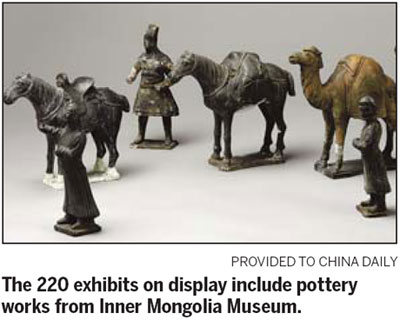Life and Leisure
US exhibition shows off Yuan Dynasty artistry
By Zhang Zixuan (China Daily)
Updated: 2010-09-30 08:02
 |
Large Medium Small |

The World of Kublai Khan: Chinese Art in the Yuan Dynasty, running until Jan 2, is wowing visitors to the Metropolitan Museum of Art (MMA), New York.
On display are representative art forms of the Yuan Dynasty (1271-1368), including paintings, sculpture, gold and silver, textiles, ceramics, lacquer and decorative arts, narrating the history from 1215, the year of Kublai's birth, to 1368, the year of the Yuan Dynasty's fall.
"The exhibition is one of the largest-scale exhibitions at MMA in recent years," says Zhixin Jason Sun, curator of the Department of Asian Art, MMA. "By covering arts of various forms, schools and ethnic groups, it will reflect the most recent research trends of Yuan history and reveal the development of the Yuan Dynasty."
Established and ruled by the Mongols, the Yuan Dynasty is most famous for its rich cultural diversity and religious tolerance. The reunification of north and south China led to radical changes in the arts, the result of the integration of regional styles and the introduction of new art forms from neighboring areas.
"It's a grand occasion that all these precious Yuan artworks can reunite at MMA," says Wang Jun, head of the Art Exhibitions China, State Administration of Cultural Heritage. "Through these exhibits, I'm sure viewers will have a better understanding of the social, economic and cultural achievements of the Yuan Dynasty that so impressed Marco Polo."
Arts from this period have a lasting influence on the arts of China up to present day.
"We have been living under the cultural shadow of the Yuan Dynasty since the 14th century, and we are just coming out of it now," says James C. Y. Watt, chairman of Asian Art, MMA, and also a curator of the exhibition.
As the major international loan exhibition of MMA this year, it took more than three years to prepare. Among the 220 exhibits, 109 of them are drawn from 23 mainland museums, the rest mainly come from Japan, Europe and the United States. The National Palace Museum in Taipei also provided exhibits, including the most widely known portrait of Kublai Khan, painted on silk.
Arranged in four parts, the exhibition opens with a section on daily life, particularly at the imperial court and the capital cities: Xanadu (in Inner Mongolia autonomous region) and Dadu (present-day Beijing). It features portraits of emperors and their consorts, as well as their costumes, jewelry and other luxury items for daily use.
Also on view are paintings and sculptures relating to the various religions practiced during that period: Buddhism, Taoism, Nestorian Christianity, Islam, Manichaeism and Hinduism. Paintings and calligraphy of every major artist and school of the period are also featured.
The last section concentrates on the decorative arts, with emphasis on porcelain, lacquer and textiles. The beginning and early development of under glaze decorated porcelain, for example, is presented by important showpieces, particularly blue-and-white, which eventually became a universal type of porcelain in both Asia and Europe.
As the major co-organizer, Art Exhibitions China has been in charge of selecting and gathering all the 109 exhibits from the 23 mainland museums. This is the second time they have collaborated with MMA to hold a large-scale Chinese art exhibition. The first was China: Dawn of a Golden Age, AD 200-750, in 2004.
"The showpieces we chose are most representative ones that can reflect the characteristics of Yuan arts in many aspects, such as gold and silver, dresses, brick carvings, religious statues, ceramics and paintings," says Zhao Gushan, head of the Execution Department, Art Exhibitions China.
To reflect the fashion of the day, several gold and silver antiques, such as ornament for a Gugu headdress, were chosen, Zhao explains.
During the Yuan Dynasty the value of an object depended on its intrinsic value. Those that were wearable or portable, such as gold, silks, pearls and gems, were considered the most highly valued.
"The Yuan Dynasty was one of the most innovative periods in the decorative arts of China. Relative to the decorative arts of previous periods, those of the Yuan Dynasty can be distinguished by a predilection for three-dimensional forms and elaborate surface decoration," says curator Watt.
To complement the major loan, MMA also organized a co-exhibition named The Yuan Revolution: Art and Dynastic Change, which showcases some 70 Yuan and early Ming (1368-1911) dynasties works of art from New York-area private and public collections.
The exhibition will last until Jan 9 in the Museum's permanent galleries for Chinese painting and calligraphy. A series of relevant lectures and film screenings are also presented.
China Daily